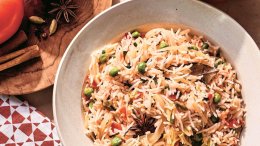Root vegetables are a pantry staple come fall in Canada, but how many varieties do you cook with and how much do you know about the history of these important ingredients? Here’s your basic guide to Canadian root vegetables.
Beets
Although some think they taste like dirt, no root vegetable is quite as Canadian as the humble red beet. If you grew up on the Prairies, you likely have childhood memories of jars upon jars of pickled beets lining your grandmother’s pantry. After all, beets are an important part of our country’s history. Many immigrants who came to Canada in the late 1800s and early 1900s worked on sugar beet farms in Alberta and beyond. Alberta and Ontario are the only provinces that still grow sugar beets, but red and other beet varieties are grown from coast to coast. Chioggia (candy cane) beets are an Italian variety with characteristic alternating red and white stripes. Using them raw helps to retain their distinct colours, as they tend to bleed together once cooked. That being said, red beets are one of nature’s best dyes. Try making beet pasta or beet bread using the juice for a striking fuchsia colour. Don’t forget to use the greens either! They can be sautéed just like Swiss chard or kale.
Carrots
Almost 9,000 hectares of land are dedicated to growing carrots in Canada, with the majority of the production being in Ontario and Quebec. These two provinces account for over 70 per cent of the carrots grown in the country. Carrots were originally used for medicinal purposes in Afghanistan, before being introduced to Europe in Medieval times. Their success in Canada isn’t surprising really, given that they thrive in cool climates, which bring out the most of their natural sugars. Fun fact: carrots are actually a member of the parsley family, which explains the similarities between carrot tops and their sister herb. Similar to parsley, carrot tops are great blended into pesto, herb oils, and other sauces. As for the carrots themselves, heirloom carrots like baby Thumbelinas are perfect simply roasted with salt and pepper, or steamed and sautéed in a healthy amount of butter to highlight their natural sweetness.
Celeriac
Celeriac or celery root isn’t the most beautiful vegetable in the world, but it’s definitely tasty! It is specifically grown for its bulbous, underground root, rather than its aboveground stalks. Celeriac originated in the Mediterranean, where it actually grows wild in some places. Here in Canada, cultivated celeriac can be found across the country and is harvested during the autumn months, but overall, it is much less familiar to Canadians than other root vegetables. There are plenty of ways to prepare this under-utilized root veg. Cooked celeriac can be pureed into a healthy mash (it’s a great alternative to mashed potatoes around your holiday dinner table) or a creamy soup, garnished with crispy celery leaves for an added touch. As are all root vegetables, it’s also wonderfully snackable when dehydrated into thin, crispy chips.
Kohlrabi
If you’re not already on the kohlrabi bandwagon, you will be soon enough. First, there was kale, then came cauliflower, and now kohlrabi is hitting the scene as the trendiest vegetable of the season. A member of the brassica family, it’s a pale green or purple bulb that is very popular in German-speaking countries. In Canada, its commercial production is limited and it is more common as a garden crop and can commonly be found at your local farmers’ market. However, Agriculture Canada found that the average amount of kohlrabi available for consumption was 0.8 kilograms per person in 2014, which was more than other root vegetables like beets or parsnips. It can be eaten raw or cooked, but is best peeled before preparing, as the thick skin is quite tough. Try pickled kohlrabi as a new accompaniment to a charcuterie plate or sprinkled atop your favourite fall salad.
Parsnips
They might look like white carrots, but if you’ve ever tasted them, you know that parsnips are a different vegetable entirely and aren't quite as appealing eaten raw, even though they belong to the same family. They were originally brought to Canada by European colonists in the early 1600s and have been popular ever since. The majority of parsnip production is done in Ontario, with an estimated $5 M worth of parsnips produced annually. Your gut instinct for preparing parsnips might be to roast them, or mash them, both of which are suitable preparations, but you can also get creative by swapping grated carrots for grated parsnips in your favourite carrot muffin or cake recipes. It’s a subtle difference but it can put some flair into a classic dessert.
Sunchokes (Jerusalem artichokes)
Sunchokes, which come from a species of sunflower, are technically not a root vegetable, but rather a tuber. Unlike the other vegetables on this list, they are in fact native to North America, specifically Eastern regions of Canada and the United States. Sunchokes grow wild and are also cultivated, although many farmers find them to be a nuisance because of their ability to spread. They look a bit like the lovechild of a baby potato and ginger, but taste nothing like either. Rather, they have a sweet, nutty flavour somewhat similar to that of water chestnuts. You don’t have to do much to them to make them taste good. They don’t have to be peeled, just scrub the skins thoroughly to remove any dirt or grit. If you’re looking for a new way to warm up on a chilly fall day, they make a wonderful soup blended together with stock and aromatics.
Turnips and rutabaga
Although not identical, turnips and rutabaga are two closely related root vegetables that can be used in similar applications. Both are members of the brassica family and originated in Northern Europe. Here, Statistics Canada reports that over 50,000 tonnes of turnips and rutabagas were grown in 2008. Whereas rutabagas are larger, with more yellow-coloured flesh, turnips are smaller with more white-coloured flesh. Taste-wise, both have a bit of that sulphurous funk that you might dread based on your childhood experiences with them, but rutabagas are typically a bit sweeter. If the taste turns you off, look for baby turnips as they are typically more tender and have a milder flavour. Try roasting them and glazing them with a combination of maple syrup and white miso paste for a sweet and salty balance.













